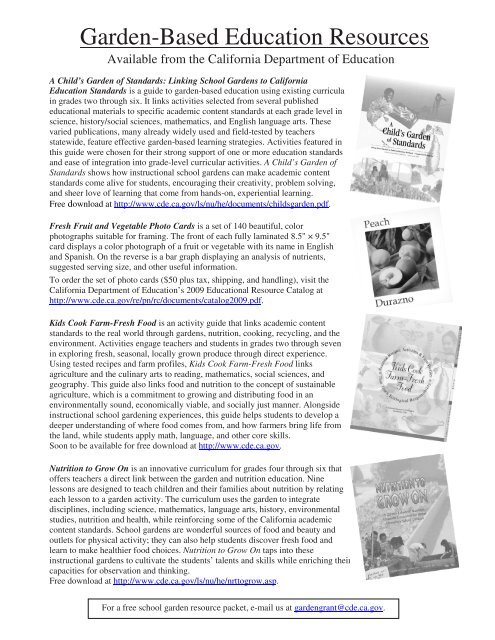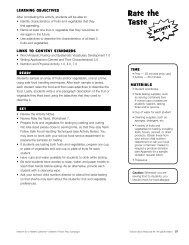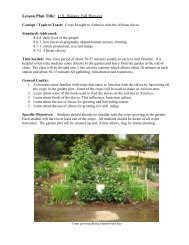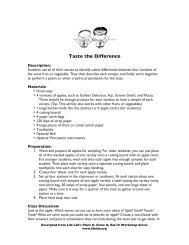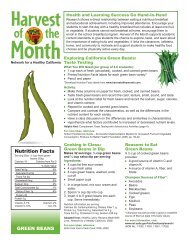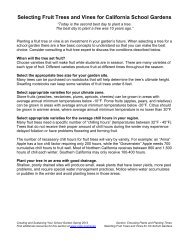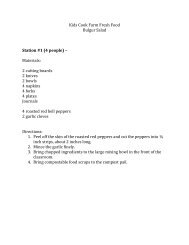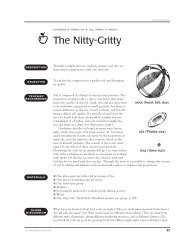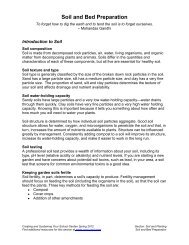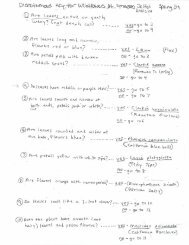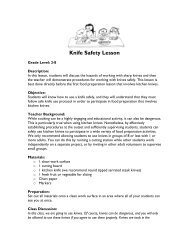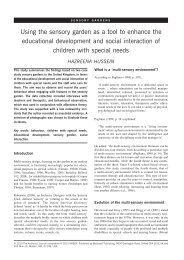Free School Garden Resources from the CDE.pdf - California ...
Free School Garden Resources from the CDE.pdf - California ...
Free School Garden Resources from the CDE.pdf - California ...
Create successful ePaper yourself
Turn your PDF publications into a flip-book with our unique Google optimized e-Paper software.
<strong>Garden</strong>-Based Education <strong>Resources</strong><br />
Available <strong>from</strong> <strong>the</strong> <strong>California</strong> Department of Education<br />
A Child’s <strong>Garden</strong> of Standards: Linking <strong>School</strong> <strong>Garden</strong>s to <strong>California</strong><br />
Education Standards is a guide to garden-based education using existing curricula<br />
in grades two through six. It links activities selected <strong>from</strong> several published<br />
educational materials to specific academic content standards at each grade level in<br />
science, history/social sciences, ma<strong>the</strong>matics, and English language arts. These<br />
varied publications, many already widely used and field-tested by teachers<br />
statewide, feature effective garden-based learning strategies. Activities featured in<br />
this guide were chosen for <strong>the</strong>ir strong support of one or more education standards<br />
and ease of integration into grade-level curricular activities. A Child’s <strong>Garden</strong> of<br />
Standards shows how instructional school gardens can make academic content<br />
standards come alive for students, encouraging <strong>the</strong>ir creativity, problem solving,<br />
and sheer love of learning that come <strong>from</strong> hands-on, experiential learning.<br />
<strong>Free</strong> download at http://www.cde.ca.gov/ls/nu/he/documents/childsgarden.<strong>pdf</strong>.<br />
Fresh Fruit and Vegetable Photo Cards is a set of 140 beautiful, color<br />
photographs suitable for framing. The front of each fully laminated 8.5" × 9.5"<br />
card displays a color photograph of a fruit or vegetable with its name in English<br />
and Spanish. On <strong>the</strong> reverse is a bar graph displaying an analysis of nutrients,<br />
suggested serving size, and o<strong>the</strong>r useful information.<br />
To order <strong>the</strong> set of photo cards ($50 plus tax, shipping, and handling), visit <strong>the</strong><br />
<strong>California</strong> Department of Education’s 2009 Educational Resource Catalog at<br />
http://www.cde.ca.gov/re/pn/rc/documents/catalog2009.<strong>pdf</strong>.<br />
Kids Cook Farm-Fresh Food is an activity guide that links academic content<br />
standards to <strong>the</strong> real world through gardens, nutrition, cooking, recycling, and <strong>the</strong><br />
environment. Activities engage teachers and students in grades two through seven<br />
in exploring fresh, seasonal, locally grown produce through direct experience.<br />
Using tested recipes and farm profiles, Kids Cook Farm-Fresh Food links<br />
agriculture and <strong>the</strong> culinary arts to reading, ma<strong>the</strong>matics, social sciences, and<br />
geography. This guide also links food and nutrition to <strong>the</strong> concept of sustainable<br />
agriculture, which is a commitment to growing and distributing food in an<br />
environmentally sound, economically viable, and socially just manner. Alongside<br />
instructional school gardening experiences, this guide helps students to develop a<br />
deeper understanding of where food comes <strong>from</strong>, and how farmers bring life <strong>from</strong><br />
<strong>the</strong> land, while students apply math, language, and o<strong>the</strong>r core skills.<br />
Soon to be available for free download at http://www.cde.ca.gov.<br />
Nutrition to Grow On is an innovative curriculum for grades four through six that<br />
offers teachers a direct link between <strong>the</strong> garden and nutrition education. Nine<br />
lessons are designed to teach children and <strong>the</strong>ir families about nutrition by relating<br />
each lesson to a garden activity. The curriculum uses <strong>the</strong> garden to integrate<br />
disciplines, including science, ma<strong>the</strong>matics, language arts, history, environmental<br />
studies, nutrition and health, while reinforcing some of <strong>the</strong> <strong>California</strong> academic<br />
content standards. <strong>School</strong> gardens are wonderful sources of food and beauty and<br />
outlets for physical activity; <strong>the</strong>y can also help students discover fresh food and<br />
learn to make healthier food choices. Nutrition to Grow On taps into <strong>the</strong>se<br />
instructional gardens to cultivate <strong>the</strong> students’ talents and skills while enriching <strong>the</strong>ir<br />
capacities for observation and thinking.<br />
<strong>Free</strong> download at http://www.cde.ca.gov/ls/nu/he/nrttogrow.asp.<br />
For a free school garden resource packet, e-mail us at gardengrant@cde.ca.gov.
O<strong>the</strong>r <strong>School</strong> <strong>Garden</strong> <strong>Resources</strong><br />
<strong>Garden</strong>s for Learning: A comprehensive guidebook that provides a strong foundation to support <strong>the</strong> growing school garden movement.<br />
It was developed by a team of experienced garden educators, nutritionists, state officials, and o<strong>the</strong>r garden experts. This guidebook is a<br />
must-have resource for anyone looking to enhance learning through <strong>the</strong> use of gardens in schools and o<strong>the</strong>r community settings.<br />
http://www.csgn.org/page.php?id=36<br />
<strong>Garden</strong>s for Learning Standards Supplement: The <strong>California</strong> Foundation for Agriculture in <strong>the</strong> Classroom has produced a supplement<br />
to <strong>the</strong> <strong>Garden</strong>s for Learning book. This supplement maps <strong>the</strong> activities mentioned in <strong>the</strong> book to <strong>California</strong> State Education Standards for<br />
grades K-6. You can download or request a free copy at www.cfaitc.org/gardensforlearning.<br />
Farming is Food, Fiber, Flowers... And Fun: A Workbook and Resource Guide for Growers of <strong>School</strong> <strong>Garden</strong>s: A workbook<br />
created by <strong>the</strong> <strong>California</strong> Foundation for Agriculture in <strong>the</strong> Classroom designed to help you plan a garden project. Browse<br />
http://www.cfaitc.org/ for loads of resources to connect your students to agriculture. http://www.cfaitc.org/<strong>Garden</strong>Guide/<strong>Garden</strong>Guide.php<br />
Plant a Seed, Watch it Grow: Web based guide to starting, caring for, and teaching in a school garden created by <strong>the</strong> Master <strong>Garden</strong>er<br />
Association of San Diego. http://www.mastergardenerssandiego.org/plantaseed/index.html<br />
Student's Guide to Composting: Composting in <strong>the</strong> Classroom: Scientific Inquiry for High <strong>School</strong> Students, by Nancy Trautmann and<br />
Marianne Krasny is a comprehensive guide for teachers interested in guiding compost research projects by high school students.<br />
http://compost.css.cornell.edu/CIC.html<br />
Fruits and Vegetables for Health: The comprehensive unit, created by <strong>the</strong> <strong>California</strong> Foundation for Agriculture in <strong>the</strong> Classroom,<br />
teaches students about <strong>the</strong> production, distribution, and nutritional value of <strong>California</strong> fresh produce, Geography, language arts,<br />
ma<strong>the</strong>matics, science, health, and nutrition concepts are incorporated. Aligned to <strong>the</strong> Content Standards for <strong>California</strong> Public <strong>School</strong>s.<br />
http://www.cfaitc.org/Lesson Plans/LessonPlans.php?details=409<br />
Healthy Foods From Healthy Soils: A Hands-On Resource For Teachers: by Patten, Elizabeth and Lyons, Kathy. Tilbury House<br />
Publishers, 2003. Simple concepts and fun activities to show children <strong>the</strong> big picture-how quality soil is <strong>the</strong> basis of nutritious foods, and<br />
how eating a variety of wholesome foods leads to healthy bodies. The program enhances existing curricula through methods that include<br />
writing, art, scientific investigation, music, and puppetry. http://www.tilburyhouse.com/Children%27s%20Franes/child_health_fr.html<br />
TWIGS: Teams with Intergenerational Support: U.C. Cooperative Extension, 30 lessons for children, K-6, to help <strong>the</strong>m connect<br />
principles of good nutrition with gardening. The materials cross age boundaries, making it easy for teens or seniors to use <strong>the</strong> materials<br />
with children. 1997. http://cesanmateo.ucdavis.edu/Custom_Program850/<br />
Sustainable Agriculture <strong>Resources</strong> and Programs for K-12 Youth: This 16-page (PDF) guide to sustainable agriculture-oriented<br />
educational opportunities for schoolchildren features more than 50 programs and curricula nationwide. Includes direct links, program<br />
contract information and ideas for integrating lessons into school programs. http://www.sare.org/publications/edguide/htm<br />
<strong>California</strong> Farm to <strong>School</strong> Program: <strong>California</strong> Programs that connect schools with local farms with <strong>the</strong> objectives of serving healthy<br />
meals in school cafeterias, improving student nutrition, providing health and nutrition education opportunities that will last a lifetime, and<br />
supporting local small farmers. http://www.cafarmtoschool.org/<br />
Creating and Sustaining Your <strong>School</strong> <strong>Garden</strong> Workshop Trainer <strong>Resources</strong>: Find downloads for all printed materials needed to<br />
conduct a Creating and Sustaining Your <strong>School</strong> <strong>Garden</strong> Workshop. In addition <strong>the</strong>re are downloads of <strong>the</strong> Power of <strong>School</strong> <strong>Garden</strong>s<br />
PowerPoint, a sample evaluation, sample workshop flier, sample agenda, workshop supply list, and a list of all workshop handouts to aid<br />
you in creating your workshop. http://www.csgn.org/page.php?id=75<br />
Life Lab Publications: The Growing Classroom: <strong>Garden</strong>-Based Science New Edition: 480 pages of science, math and language arts<br />
activities that you can do with you students in <strong>the</strong> garden. Activities are aligned with <strong>the</strong> <strong>California</strong> State Science Content Standards.<br />
Topics include soil, plants, cycles, ecology, wea<strong>the</strong>r, nutrition and food systems. Also include team-building and sensory exploration<br />
activities, organic gardening skills and information on how to create and sustain a successful school garden program. $39.95, order online<br />
and view alignment to <strong>California</strong> State Science Standards at: www.lifelab.org


